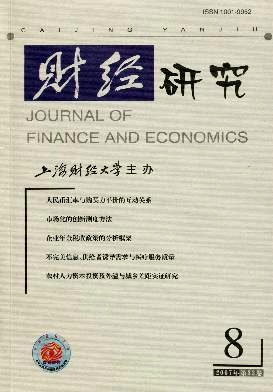中国交通基础设施与经济增长的区域比较分析
财经研究 2007 年 第 33 卷第 08 期, 页码:52 - 64
摘要
参考文献
摘要
20世纪80年代以来,经济学家主要运用生产函数法,分别建立时间序列模型与面板数据模型对交通基础设施与经济增长的关系进行实证分析,利用前者所得的结论由于得出的交通基础设施弹性太大而并不可信,利用后者得出的结论又由于弹性过小而与现实情况相矛盾。文章通过对中国交通基础设施水平区域差异状况的分析以及交通基础设施水平与区域经济增长关系的面板数据研究,试图揭示交通基础设施水平与中国区域经济增长之间的关系,并讨论了交通先行在中部崛起中的作用。结论为:(1)中国的交通基础设施与经济增长表现出很强的空间聚集特征,经济增长与交通运输主要集中在东部沿海发达地区,并形成了由东往西逐步递减的梯度。(2)交通基础设施对经济增长的弹性值为0.0563~0.2058,介于早期学者运用时间序列数据与面板数据得出的弹性值之间,且此结论较为稳健。(3)从交通基础设施对经济增长贡献的区域差异来看,中部地区交通基础设施对经济增长的贡献最大,表明交通先行在中部崛起中起着重要的作用。
[1]Aschauer,David Alan.Is public expenditure productive[J].Journal of Monetary Eco-nomics,1989,(23):177~200.
[2]Adelheid Holl.Transport infrastructure,agglomeration economies,and firm birth:Em-pirical evidence fromportugal[J].Journal of Regional Science,2004,44(4):693~712.
[3]Holtz-Eakin D.Public sector capital and the productivity puzzle[J].Review of Econom-ics and Statistics,1994,76(1):12~21.
[4]Kilkenny,Maureen.Transport costs and rural development[J].Journal of Regional Sci-ence,1998,38(2):293~312.
[5]Marlon G Boarnet.Spillovers and the locational effects of public infrastructure[J].Jour-nal of Regional Science,1998,38(3):381~400.
[6]Munnell,Alicia H.Why has productivity declined?Productivity and public invest ment[J].New England Economic Review,1990,January/February:3~22.
[7]Munnell,Alicia H.Infrastructure invest ment and economic growth[J].Journal of eco-nomic perspectives,1992,6(4):189~198.
[8]Oosterhaven Jan,Knaap Thijs.Spatial economic i mpacts of transport infrastructure in-vest ment[R].Paper Prepared for the TRANS-TALK Thematic Network,Brussels,Re-vised Version of March,2001.
[9]Ottaviano,Gianmarco,Takatoshi Tabuchi,Jacque F Thisse.Agglomeration and trade re-visited[J].International Economic Review,2002,43(2):101~127.
[10]Rietveld P,Nijkamp P.Transport infrastructure and regional development[A].Polak JB,Heertje A.(eds)Analytical Transport Economics:An international perspective[C].Cheltenham:Edward Elgar Pub.2000.
[11]刘南.交通项目经济效益评估的理论方法与应用[M].太原:山西人民出版社,2003.
[12]唐建新.基础设施与经济增长——兼论我国基础设施“瓶颈”约束产生的原因与对策[J].经济评论,1998,(2):47~50.
[13]王辰.基础产业瓶颈:体制与非体制成因的系统考察[J].管理世界,1995(3):132~138.
[14]亚当.斯密.国民财富的性质和原因的研究[M].北京:商务出版社,1983.
[15]杨荫凯,韩增林.交通经济带的基本理论探讨[J].人文地理,1999,(2):1~5.
[16]张文尝,金凤君,樊杰.交通经济带[M].北京:科学出版社,2002.
[2]Adelheid Holl.Transport infrastructure,agglomeration economies,and firm birth:Em-pirical evidence fromportugal[J].Journal of Regional Science,2004,44(4):693~712.
[3]Holtz-Eakin D.Public sector capital and the productivity puzzle[J].Review of Econom-ics and Statistics,1994,76(1):12~21.
[4]Kilkenny,Maureen.Transport costs and rural development[J].Journal of Regional Sci-ence,1998,38(2):293~312.
[5]Marlon G Boarnet.Spillovers and the locational effects of public infrastructure[J].Jour-nal of Regional Science,1998,38(3):381~400.
[6]Munnell,Alicia H.Why has productivity declined?Productivity and public invest ment[J].New England Economic Review,1990,January/February:3~22.
[7]Munnell,Alicia H.Infrastructure invest ment and economic growth[J].Journal of eco-nomic perspectives,1992,6(4):189~198.
[8]Oosterhaven Jan,Knaap Thijs.Spatial economic i mpacts of transport infrastructure in-vest ment[R].Paper Prepared for the TRANS-TALK Thematic Network,Brussels,Re-vised Version of March,2001.
[9]Ottaviano,Gianmarco,Takatoshi Tabuchi,Jacque F Thisse.Agglomeration and trade re-visited[J].International Economic Review,2002,43(2):101~127.
[10]Rietveld P,Nijkamp P.Transport infrastructure and regional development[A].Polak JB,Heertje A.(eds)Analytical Transport Economics:An international perspective[C].Cheltenham:Edward Elgar Pub.2000.
[11]刘南.交通项目经济效益评估的理论方法与应用[M].太原:山西人民出版社,2003.
[12]唐建新.基础设施与经济增长——兼论我国基础设施“瓶颈”约束产生的原因与对策[J].经济评论,1998,(2):47~50.
[13]王辰.基础产业瓶颈:体制与非体制成因的系统考察[J].管理世界,1995(3):132~138.
[14]亚当.斯密.国民财富的性质和原因的研究[M].北京:商务出版社,1983.
[15]杨荫凯,韩增林.交通经济带的基本理论探讨[J].人文地理,1999,(2):1~5.
[16]张文尝,金凤君,樊杰.交通经济带[M].北京:科学出版社,2002.
引用本文
张学良. 中国交通基础设施与经济增长的区域比较分析[J]. 财经研究, 2007, 33(8): 52–64.
导出参考文献,格式为:
下一篇:企业年金税收政策的分析框架





 7754
7754  959
959

